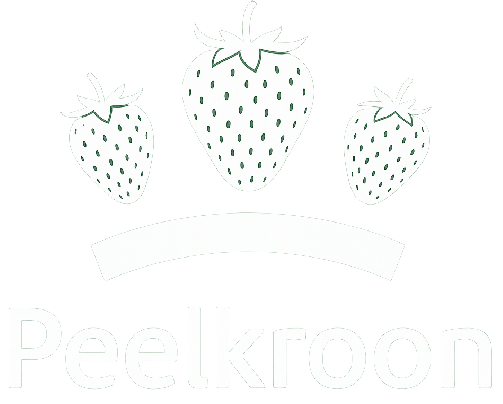
- Industry: Strawberry Grower
- Region: Europe
From Reactive to Proactive: How Gardin Pulse Transformed Climate Decisions at Peelkroon Berries
- Highlighted
unseen risks - Smarter
shading decisions - Prevented
10% yield loss - Protected
crops and profits
Summary
- 10% loss in productivity linked to light stress during high-sun periods.
- Real-time plant feedback exposed unseen risks in climate strategy.
- Smarter shading decisions helped maintain plant health and protect yield.
"We pay closer attention to the shading strategy now we work with Gardin, and take better steps to plan for periods of high light, like we have seen this year. Gardin has helped us to think more about the long-term effects of our crop strategy on plant health rather than choosing short term gains."
Rob Van Enckevort, Owner and Grower at De Peelkroon

Fig 1 - Light stress in plants caused a 8% cumulative productivity loss, equivalent to 7 mol/m2 of photosynthesis. Hypothetical strategy which shaded at 900umol would have achieved more total production despite lower light sums.
In April 2025, De Peelkroon, a leading Dutch strawberry grower, trialled a no-shading approach during high light intensities, hoping to boost growth. Crop observations suggested that the plants were performing well, but Gardin's real-time plant data showed a different picture. Photosynthetic efficiency breached safe thresholds, and night-time recovery was poor, pointing to unseen light stress. The crop suffered a 8% production loss in just one month.
Gardin's feedback has now changed how shading is used at De Peelkroon, helping the team protect plant health during high-light conditions and maintain yield potential over the long term.
Introduction
In this case study, Gardin's photosynthesis sensor helped Peelkroon Berries identify light stress that traditional metrics missed. While high transpiration rates suggested robust growth, Gardin's sensors revealed that plants were struggling to convert light into energy efficiently. By uncovering this hidden stress early, Gardin empowered the grower to adapt their shading strategy, protect yield, and avoid long-term damage, ultimately demonstrating how plant feedback can transform climate control decisions from reactive to proactive.
Results & Discussion
A Challenging Season with High Light Stress
April 2025 saw a sustained period of unusually high light combined with a dry and relatively cool climate. This created a challenge for growers by straining Vapor Pressure Deficit (VPD) conditions. Under these conditions it is common to apply shading to reduce incoming light levels and raise greenhouse humidity.
De Peelkroon are a leading strawberry grower based in the Netherlands with over 4 hectares of strawberry crops owned and operated by Rob Van Enckevort. Given the high light available early in the season, instead of applying shading as usual, Rob allowed light levels to rise freely, testing the impact on greenhouse climate and plant performance.
On April 3rd, the shades were left open and PAR levels allowed to reach above 1,000 µmol/m²/s and peak near 1,200 µmol/m²/s. Inside greenhouse temperature peaked at 24°C and leaf temperature at 32°C. April 4th had a very similar outside climate but on this day the shades were closed, the inside greenhouse temperature reached 26°C and the leaf temperature fell to 28°C.
Whilst 32 degrees would normally be regarded as a very high leaf temperature that would cause stomata to close, transpiration and water usage was actually higher on the day without shading. Most growers would typically observe this as the plants coping well with the high light and having a positive impact on rates of photosynthesis and water movement through the plant.

Fig. 2 Left: Rob van Enckevort, Owner and Grower at De Peelkroon. Right: Mark van der Werf, Plant Health Consultant from Plant Empowerment.
Gardin's Insights Enable Real Time Response
Gardin fills a critical gap by measuring real-time plant light response and photosynthetic efficiency. It guides growers with two lighting strategies: an energy-efficient mode to light conversion using LEDs in Winter, and an aggressive mode to maximise lighting without stressing plants in the summer.
On April 3rd at De Peelkroon, lack of shading led to light levels that stressed the plant, pushing efficiency below the safe threshold and lowering night-time recovery. After shading was applied on April 4th, stress was avoided, and night-time efficiency improved as the plants had time to recover.
Despite these early warnings from Gardin's plant feedback, improvements in transpiration convinced Rob to test a no-shading strategy. Over the next month, plant health declined significantly in two greenhouse zones monitored by Gardin. Poor plant health reduces readiness for growth and photosynthetic efficiency, leading to smaller leaf area, lower fruit quality, and, in some cases, fruit abortion.
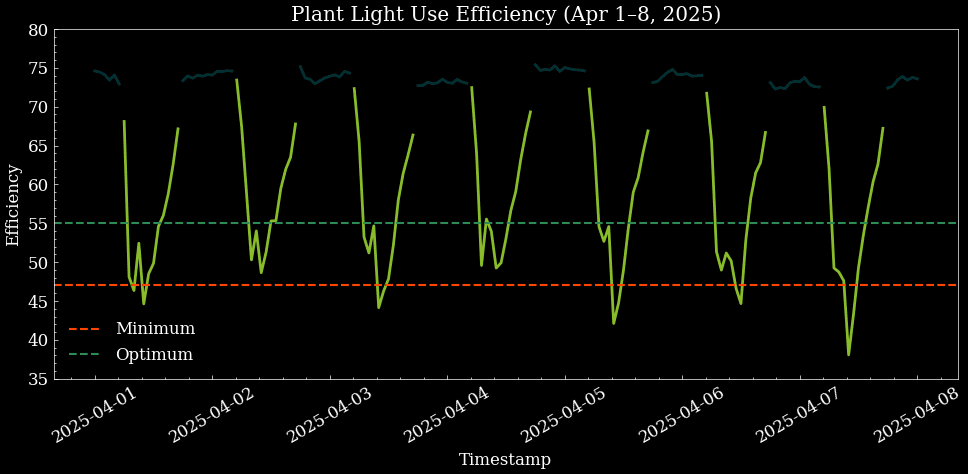
Fig. 3 Plant Light Use Efficiency in first week of April 2025 during De Peelkroon's 'No-Shading Period', showing efficiency falling below minimum level.

Fig. 4 Plant Health Change from March to May 2025, showing a decrease in health in two sections after the start of the ‘No Shading Period' at De Peelkroon.
Result: 10% Preventable Productivity Loss
This study used Gardin sensor data to estimate potential production had the plants maintained their high health scores from early April, before light stress, by modelling the plant light response (R2 score = 70%). The results showed that with no-shading, photosynthetic efficiency dropped well below expected levels, indicating less of the available light was converted into assimilates.
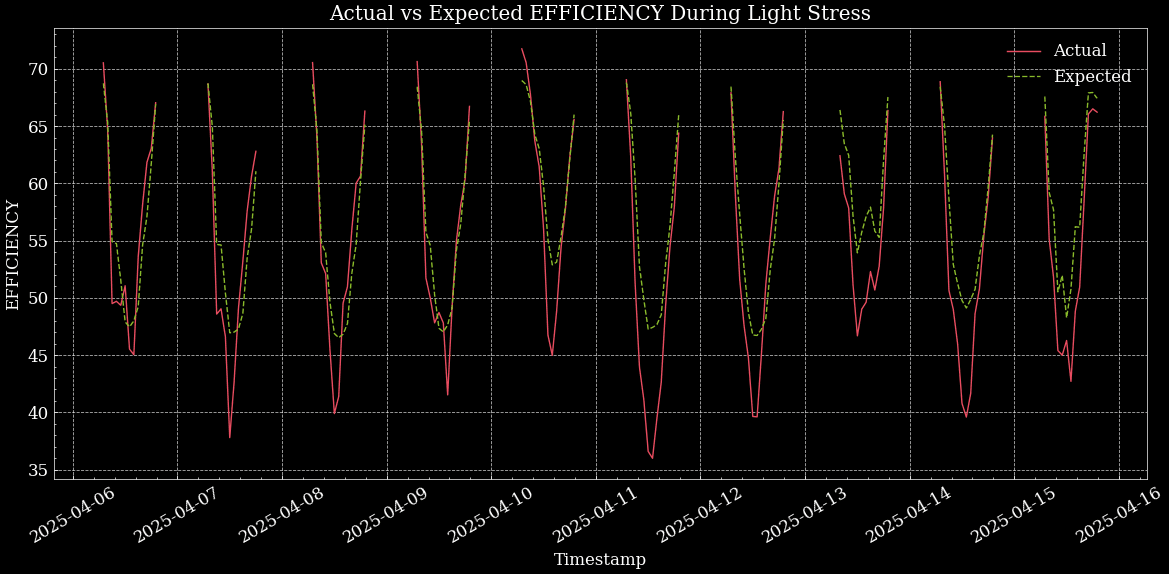
Fig. 5 Actual vs Expected Efficiency during No-Shading Period, April 2025 at De Peelkroon. Graft shows actual efficiency dropping below expected.
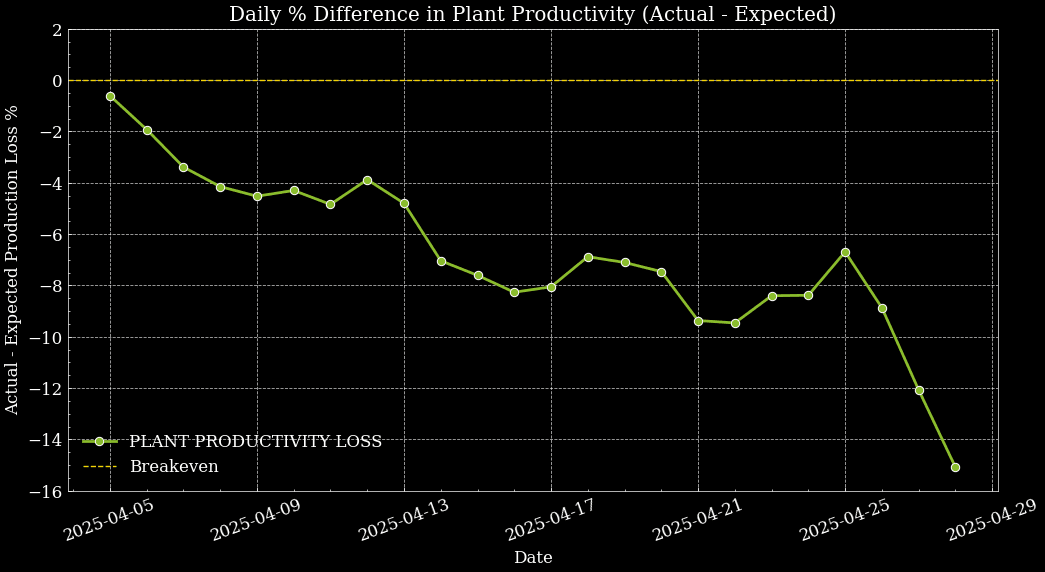
Fig. 6 Daily Percentage Difference in Plant Productivity during No-Shading Period, April 2025. Graph shows a decrease in two sections of De Peelkroon.
Plant productivity is calculated by combining the expected light use efficiency and incident light (PPFD), to give the electron transport for photosynthesis. The lack of shading and resulting plant stress resulted in a cumulative assimilate deficit over time. In April, this deficit reached 10% in both monitored greenhouse sections. Based on Gardin's historical yield models, this loss would correspond to an estimated 6% reduction in strawberry yield.
The model also indicates that if shading had been used to cap the canopy-level PPFD at 900 µmol/m²/s, total productivity would still have been higher by the end of the month. This provides compelling evidence that an informed shading strategy does not reduce growth; due to the long-term benefits of mitigating light stress on photosynthetic efficiency.
Final Photosynthesis Results
| Greenhouse | Actual (mol/m2) | Expected (mol/m2) | Difference (mol/m2) | % Diff Abs |
|---|---|---|---|---|
| Section A | 95.7 | 104.9 | -9.2 | 9.6 |
| Section B | 94.1 | 101.0 | -6.9 | 7.3 |
The actual assimilate loss and benefits of shading likely exceed 10%, as early growth would have boosted leaf area and light interception, amplifying productivity over time. This analysis only considered linear productivity per leaf area, not the compounding effect of expanding canopy coverage over the greenhouse area, which will be explored in future research.

Fig 7 - Light stress in plants caused a 8% cumulative productivity loss, equivalent to 7 mol/m2 of photosynthesis. Hypothetical strategy which shaded at 900umol would have achieved more total production despite lower light sums.
Conclusions
These results highlight the critical need to evaluate greenhouse climate strategies through the lens of plant photosynthesis. Not doing so risks drawing incorrect conclusions which can result in significant losses in monthly production of 10%. In this study, high transpiration levels gave the impression of plants coping well under bright conditions, but this led to an incorrect shading strategy and caused long term damage to the plant photosystem.
Rob reflected on these insights from Gardin - "We pay much closer attention to the shading strategy now we work with Gardin, and take better steps to plan for periods of high light, like we have seen this year. Gardin has helped us to think more about the long term effects of our crop strategy on plant health rather than just choosing short term gains".
Gardin offers an easy to use, fully autonomous system for monitoring crop photosynthesis. Its insights help growers target the optimal climate strategy, including lighting and shading to maximise yield at the lowest cost.

To start your journey towards understanding your plants better, please contact us to start the sales process.
RELATED CASE STUDY
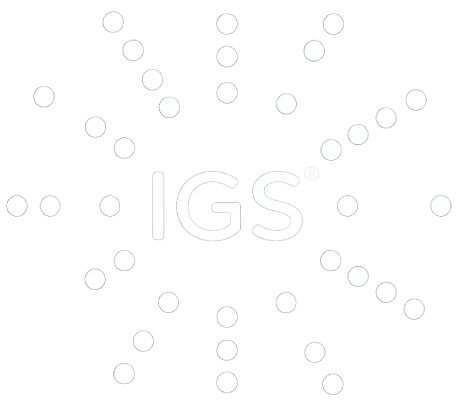
40% Yield Increase with Light Recipe Optimisation
Should your case study be featured here?
Speak to our team to find out what Gardin Pulse will unlock for you.
Contact sales